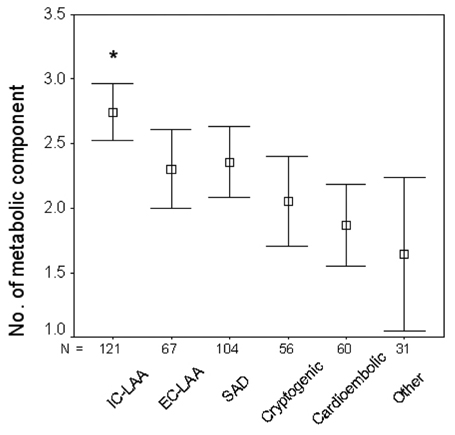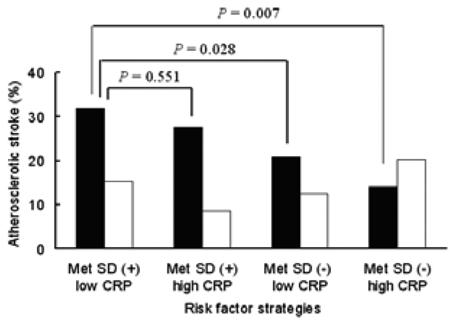J Clin Neurol.
2005 Apr;1(1):69-75. 10.3988/jcn.2005.1.1.69.
Association of Metabolic Syndrome and C-reactive Protein Levels with Intracranial Atherosclerotic Stroke
- Affiliations
-
- 1Department of Neurology, Ajou University School of Medicine, Suwon, Korea. nmboy@unitel.co.kr
- KMID: 2287715
- DOI: http://doi.org/10.3988/jcn.2005.1.1.69
Abstract
- BACKGROUND
The risk factors for intracranial atherosclerosis are unclear but may differ from those for other stroke subtypes. Here, we investigated whether metabolic syndrome, an emerging risk factor for cardiovascular disease, is associated with intracranial atherosclerotic stroke.
METHODS
Using the Adults Treatment Panel III criteria, we evaluated the components of metabolic syndrome in 439 patients with ischemic stroke or transient ischemic attacks. The prevalence of metabolic syndrome within each stroke subtype was determined, and the association between intracranial atherosclerosis and metabolic syndrome was evaluated.
RESULTS
Metabolic syndrome was observed more frequently in patients with intracranial atherosclerosis than in those with other types of stroke (P=0.003). In a multiple regression analysis, metabolic syndrome, but not conventional risk factors, was independently associated with intracranial atherosclerosis (P=0.016). By contrast, the serum level of C-reactive protein was correlated negatively with the presence of intracranial atherosclerosis. Intracranial atherosclerosis was most prevalent in patients with metabolic syndrome and low levels of C-reactive protein (P=0.024).
CONCLUSIONS
Our results indicate that metabolic syndrome is a strong independent risk factor for intracranial atherosclerotic stroke. Therefore, treatment of metabolic abnormalities may be an important prevention strategy for intracranial atherosclerotic stroke.
MeSH Terms
Figure
Reference
-
1. Wong KS, Huang YN, Gao S, Lam WW, Chan YL, Kay R. Intracranial stenosis in Chinese patients with acute stroke. Neurology. 1998. 50:812–813.
Article2. Expert Panel on Detection, Evaluation, and Treatment of High Blood Cholesterol in Adults. Executive Summary of The Third Report of The National Cholesterol Education Program (NCEP) Expert Panel on Detection, Evaluation, And Treatment of High Blood Cholesterol In Adults (Adult Treatment Panel III). JAMA. 2001. 285:2486–2497.3. Girman CJ, Rhodes T, Mercuri M, Pyorala K, Kjekshus J, Pedersen TR, et al. The metabolic syndrome and risk of major coronary events in the Scandinavian Simvastatin Survival Study (4S) and the Air Force/Texas Coronary Atherosclerosis Prevention Study (AFCAPS/TexCAPS). Am J Cardiol. 2004. 93:136–141.
Article4. Bang OY, Lee PH, Joo SY, Lee JS, Joo IS, Huh K. Frequency and mechanisms of stroke recurrence after cryptogenic stroke. Ann Neurol. 2003. 54:227–234.
Article5. Lee PH, Bang OY, Oh SH, Joo IS, Huh K. Subcortical white matter infarcts: comparison of superficial perforating artery and internal border-zone infarcts using diffusion-weighted magnetic resonance imaging. Stroke. 2003. 34:2630–2635.6. Adams HP Jr, Bendixen BH, Kappelle LJ, Biller J, Love BB, Gordon DL, Marsh EE 3rd. Classification of subtype of acute ischemic stroke. Definitions for use in a multicenter clinical trial. TOAST. Trial of Org 10172 in Acute Stroke Treatment. Stroke. 1993. 24:35–41.
Article7. Samuels OB, Joseph GJ, Lynn MJ, Smith HA, Chimowitz MI. A standardized method for measuring intracranial arterial stenosis. Am J Neuroradiol. 2000. 21:643–646.8. North American Symptomatic Carotid Endarterectomy Trial Collaborator. Beneficial effect of carotid endarterectomy in symptomatic patients with high degree stenosis. N Engl J Med. 1991. 325:445–453.9. Inoue S, Zimmet P, Catersen I, Chunming C, Ikeda Y, Khalid AK, et al. The Asia-Pacific perspective: redefining obesity and its treatment. 2000. Health Communication Australia Pty.10. 2002. In : Centers for Disease Control/American Heart Association Workshop on Inflammatory Markers, and Cardiovascular Disease: application to clinical and public health practice; March 14-15, 2002; Atlanta. Atlanta, Ga: Centers for Disease Control and Prevention.11. Hulthe J, Bokemark L, Wikstrand J, Fagerberg B. The metabolic syndrome, LDL particle size, and atherosclerosis: the atherosclerosis and insulin resistance (AIR) study. Arterioscler Thromb Vasc Biol. 2000. 20:2014–2017.12. Olijhoek JK, van der Graaf Y, Banga JD, Algra A, Rabelink TJ, Visseren FL, et al. The metabolic syndrome is associated with advanced vascular damage in patients with coronary heart disease, stroke, peripheral arterial disease or abdominal aortic aneurysm. Eur Heart J. 2004. 25:342–348.
Article13. Cai H, Harrison DG. Endothelial dysfunction in cardiovascular diseases: the role of oxidant stress. Circ Res. 2000. 87:840–844.
Article14. Sakkinen PA, Wahl P, Cushman M, Lewis MR, Tracy RP. Clustering of procoagulation, inflammation, and fibrinolysis variables with metabolic factors in insulin resistance syndrome. Am J Epidemiol. 2000. 152:897–907.
Article15. Ford ES, Mokdad AH, Giles WH, Brown DW. The metabolic syndrome and antioxidant concentrations: findings from the Third National Health and Nutrition Examination Survey. Diabetes. 2003. 52:2346–2352.16. D'Armiento FP, Bianchi A, de Nigris F, Capuzzi DM, D'Armiento MR, Crimi G, et al. Age-related effects on atherogenesis and scavenger enzymes of intracranial and extracranial arteries in men without classic risk factors for atherosclerosis. Stroke. 2001. 32:2472–2479.17. Shahar E, Chambless LE, Rosamond WD, Boland LL, Ballantyne CM, McGovern PG, et al. Plasma lipid profile and incident ischemic stroke: the Atherosclerosis Risk in Communities (ARIC) study. Stroke. 2003. 34:623–631.18. Ford ES. The metabolic syndrome and C-reactive protein, fibrinogen, and leukocyte count: findings from the Third National Health and Nutrition Examination Survey. Atherosclerosis. 2003. 168:351–358.
Article19. Ridker PM, Buring JE, Cook NR, Rifai N. C-reactive protein, the metabolic syndrome, and risk of incident cardiovascular events: an 8-year follow-up of 14 719 initially healthy American women. Circulation. 2003. 107:391–397.
Article
- Full Text Links
- Actions
-
Cited
- CITED
-
- Close
- Share
- Similar articles
-
- Overall and Gender-specific Associations between C-reactive Protein and Stroke Occurrence: A Cross-sectional Study in US
- Four-Year Change of Metabolic Syndrome Incidence According to Serum Uric Acid
- The Association between C-Reactive Protein and Features of the Metabolic Syndrome
- C-reactive Protein and Metabolic Syndrome
- Relationship between Hemoglobin A1c Levels and Metabolic Syndrome using Data Collected during a Medical Check-ups Program



